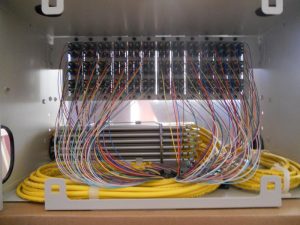Fiber Technology
When you’re planning a new network cable installation or considering upgrades to an existing network, you might want to consider using fiber optic cables.
Fiber Optic lines are strands of optically pure glass as thin as a human hair, that transmit infrared light, which carry digital information over a distance. The use of fiber optic networking is on the rise as the demand for data bandwidth is ever increasing with the growth of new technologies. Because of fiber optic technology’s immense potential bandwidth, there are extraordinary possibilities for current and future fiber optic applications.
Fiber Installation and Testing
ICWPA installs the various kinds of fiber optic cable including single mode and multi-mode and is experienced in fusion and mechanical splicing. Our Fluke test equipment is calibrated to the latest standards to insure a fully compliant system.
ICWPA is also the only certified AFL Dura-Line Jet Blown Fiber installer for the PA region between Pittsburgh and State College. This certification carries a 25-year warranty.

Fiber Advantages
Network fiber cables have some definite advantages over copper cables.
- Greater Bandwidth
Copper cables were originally designed for voice transmission and have a limited bandwidth. Fiber optic cables provide more bandwidth for carrying more data than copper cables of the same diameter. Within the fiber cable family, singlemode fiber delivers up to twice the throughput of multimode fiber. - Faster Speeds
Fiber optic cables have a core that carries light to transmit data. This allows fiber optic cables to carry signals at speeds that are only about 31 percent slower than the speed of light—faster than Cat5 or Cat6 copper cables. There is also less signal degradation with fiber cables. - Longer Distances
Fiber optic cables can carry signals much farther than the typical 328-foot limitation for copper cables. For example, some 10 Gbps singlemode fiber cables can carry signals almost 25 miles. The actual distance depends on the type of cable, the wavelength and the network. - Better Reliability
Fiber is immune to temperature changes, severe weather and moisture, all of which can hamper the connectivity of copper cable. Plus, fiber does not carry electric current, so it’s not bothered by electromagnetic interference (EMI) that can interrupt data transmission. It also does not present a fire hazard like old or worn copper cables can. - Thinner and Sturdier
Compared to copper cables, fiber optic cables are thinner and lighter in weight. Fiber can withstand more pull pressure than copper and is less prone to damage and breakage. - More Flexibility for the Future
Media converters make it possible to incorporate fiber into existing networks. The converters extend UTP Ethernet connections over fiber optic cable. Modular patch panel solutions integrate equipment with 10 Gb, 40 Gb and 100/120 Gb speeds to meet current needs and provide flexibility for future needs. The panels in these solutions accommodate a variety of cassettes for different types of fiber patch cables. - Lower Total Cost of Ownership
Although some fiber optic cables may have a higher initial cost than copper, the durability and reliability of fiber can make the total cost of ownership (TCO) lower. And, costs continue to decrease for fiber optic cables and related components as technology advances.
